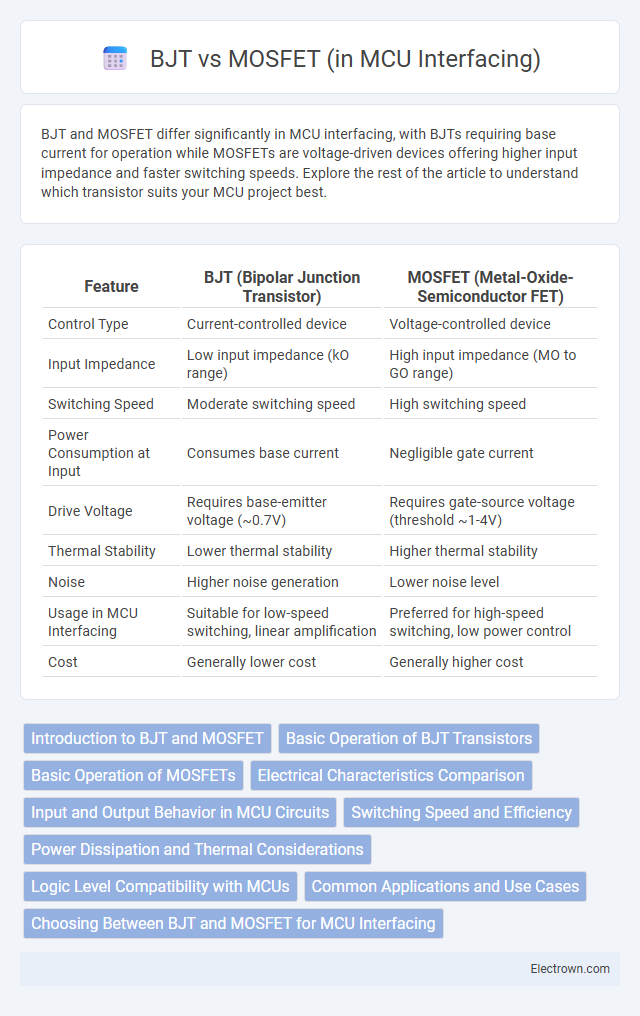BJT and MOSFET differ significantly in MCU interfacing, with BJTs requiring base current for operation while MOSFETs are voltage-driven devices offering higher input impedance and faster switching speeds. Explore the rest of the article to understand which transistor suits your MCU project best.
Table of Comparison
| Feature | BJT (Bipolar Junction Transistor) | MOSFET (Metal-Oxide-Semiconductor FET) |
|---|---|---|
| Control Type | Current-controlled device | Voltage-controlled device |
| Input Impedance | Low input impedance (kO range) | High input impedance (MO to GO range) |
| Switching Speed | Moderate switching speed | High switching speed |
| Power Consumption at Input | Consumes base current | Negligible gate current |
| Drive Voltage | Requires base-emitter voltage (~0.7V) | Requires gate-source voltage (threshold ~1-4V) |
| Thermal Stability | Lower thermal stability | Higher thermal stability |
| Noise | Higher noise generation | Lower noise level |
| Usage in MCU Interfacing | Suitable for low-speed switching, linear amplification | Preferred for high-speed switching, low power control |
| Cost | Generally lower cost | Generally higher cost |
Introduction to BJT and MOSFET
Bipolar Junction Transistors (BJTs) and Metal-Oxide-Semiconductor Field-Effect Transistors (MOSFETs) are fundamental components for MCU interfacing, each functioning as electronic switches controlled by different principles. BJTs operate based on current injection into the base terminal, resulting in current flow between the collector and emitter, whereas MOSFETs are voltage-driven devices relying on an electric field to control conductivity between the drain and source terminals. Choosing the right transistor type for your microcontroller interface depends on factors like switching speed, input impedance, and power efficiency.
Basic Operation of BJT Transistors
BJT transistors operate as current-controlled devices where a small base current controls a larger collector current, enabling switching or amplification in MCU interfacing circuits. Their operation relies on the injection of charge carriers across the base-emitter junction, making them suitable for low-voltage switching tasks with moderate speed. Understanding BJT behavior helps optimize signal integrity and power efficiency when integrating with microcontroller inputs and outputs.
Basic Operation of MOSFETs
MOSFETs operate by controlling the voltage applied to the gate terminal, which creates an electric field that modulates the conductivity of a semiconductor channel between the source and drain. This voltage-controlled mechanism allows MOSFETs to switch faster and consume less power than BJTs, making them ideal for microcontroller unit (MCU) interfacing in low-power and high-speed applications. Unlike BJTs, which rely on current flow through the base terminal, MOSFETs offer higher input impedance and better thermal stability, enhancing overall circuit efficiency.
Electrical Characteristics Comparison
BJTs exhibit higher current gain (b) and require base current for operation, while MOSFETs operate with voltage-controlled gates and negligible gate current, offering greater input impedance. MOSFETs generally have faster switching speeds and lower on-resistance (R_DS(on)), resulting in improved efficiency in MCU interfacing. The BJT's saturation voltage (V_CE(sat)) is typically higher than the MOSFET's R_DS(on), leading to increased power dissipation under load conditions.
Input and Output Behavior in MCU Circuits
BJTs in MCU interfacing exhibit current-controlled input behavior, requiring base current to switch, which can lead to increased power consumption. MOSFETs, as voltage-controlled devices, demand minimal input current, making them more efficient for high-impedance MCU inputs and enabling faster switching with lower gate drive loss. Your choice between BJT and MOSFET impacts output drive capability, with MOSFETs offering better voltage-driven output and lower saturation voltage, enhancing overall MCU circuit performance.
Switching Speed and Efficiency
MOSFETs offer significantly faster switching speeds compared to BJTs due to their voltage-driven gate operation, making them ideal for high-frequency MCU interfacing applications. MOSFETs also provide higher efficiency with lower on-resistance, resulting in reduced power losses and improved thermal performance. When optimizing your MCU circuits for rapid switching and energy-saving performance, choosing MOSFETs enhances overall system responsiveness and efficiency.
Power Dissipation and Thermal Considerations
BJT transistors generally exhibit higher power dissipation in MCU interfacing due to their continuous base current requirement, leading to increased thermal stress under load conditions. MOSFETs, with their voltage-driven gate, offer significantly lower power loss, enhancing energy efficiency and reducing heat generation in compact MCU circuits. Your design's thermal management benefits from MOSFETs' superior efficiency, minimizing the need for extensive cooling mechanisms compared to BJTs.
Logic Level Compatibility with MCUs
Bipolar Junction Transistors (BJTs) require a base current to switch and often need additional components for proper logic level interfacing with microcontrollers (MCUs), making them less ideal for direct control using 3.3V or 5V logic signals. Metal-Oxide-Semiconductor Field-Effect Transistors (MOSFETs), especially logic-level MOSFETs, feature gate thresholds compatible with typical MCU output voltages, enabling efficient switching with minimal loss. MOSFETs offer higher input impedance and prevent loading of MCU pins, enhancing signal integrity in digital control applications.
Common Applications and Use Cases
BJTs are commonly used in MCU interfacing for switching applications such as driving small motors, LEDs, and relays due to their linear amplification and fast switching capabilities. MOSFETs are preferred in power management and high-efficiency switching circuits because of their high input impedance, low on-resistance, and superior thermal performance. In low voltage and fast switching scenarios, MOSFETs are often selected for PWM control, while BJTs remain useful in analog signal amplification and simple driver circuits within microcontroller systems.
Choosing Between BJT and MOSFET for MCU Interfacing
Selecting between BJT and MOSFET for MCU interfacing depends on factors like input impedance, switching speed, and power efficiency. MOSFETs are preferred for their high input impedance, low gate current, and fast switching capabilities, making them ideal for low-power microcontroller applications. BJTs, while simpler and cost-effective, require base current and may introduce higher power dissipation, which can impact overall system performance in sensitive MCU circuits.
BJT vs MOSFET (in MCU interfacing) Infographic

 electrown.com
electrown.com